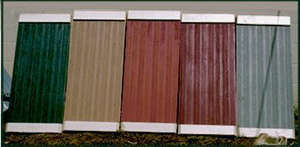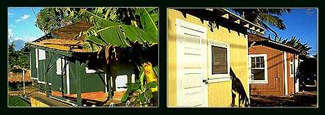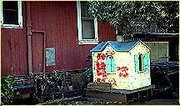The Historical Colors of Ewa Plantation

The Ewa Plantation Villages Revitalization Project was selected for the Historic Preservation Honor Award by the Historic Hawai'i Foundation.
Plantation housing is one of the unique architectural styles of the Hawaiian Islands. The Ewa homes, on the island of Oahu, were built after the turn of the century by the sugar plantation owners to house the workers who were imported from Japan, China, and the Philippines. The structures are single wall construction with cedar shingle roofs and pier posts on lava rock foundations. Their unique exterior color combinations are as much a part of their historical identity as the architectural design.

Ewa homes prior to restoration
The selection and implementation of the historical colors for the Ewa Plantation Revitalization Project included four phases.
Phase I: Identification of the Historical Colors
Two methods were used:
1. Visual Identification
The neighborhoods were surveyed and all existing color combinations were noted. Site analysis of the existing exterior paint followed. Paint scrapings from the homes were visually and microscopically analyzed. This process revealed which colors were present initially and which evolved later. Definition of what was"historical" was critical. Initially there were only a few colors, but as years passed "people" colors evolved. Some of these reflected a "collective consciousness", a response which was based on the original colors as well as the tropical environment. An example is the reddish-brown paint color which matches the iron rich soil of the area. Other colors were more personal in origin and were deleted from the final color specifications.
2. Research
Numerous archives were consulted. The most significant information came from the "old-timers" who had lived in Ewa housing for 70 years or more. (Many thanks to Sam Inouye of Ewa Village for his accurate accounts of the evolution of the housing colors.)
Advertisement
Phase 2: Definition of the Historical Color Palettes
The following conclusions resulted from the research:
The original houses were white, grey and dark brown. The white was applied as a limestone wash. The roofing shingles were stained red or green which aged to a greyish wood hue under the strong tropical light. The trim was always white. After 1936, the dark green and reddish brown hues were introduced. They were applied as stains in a two coat application. Of note is the fact that the original dark brown was covered over with the reddish brown stain. After World War II, a caramel brown, soft beige-yellow, and a subtle celadon (with a tinge of yellow) appeared. Occasionally occupants would paint the home an unusual color such as brilliant sky blue, mustard yellow, navy blue, or lime green. Also of note is that some of the shutters were repainted a dark green at a later date.
The following historical colors were specified for the siding, lattice, and skirt:
white, grey, reddish brown, dark green, beige-yellow, and caramel brown.
An off-white was specified for the trim , including the shutters where applicable. A natural cedar roof was specified.
Phase 3: Brush-outs and Specifications

Preparation of brush-outs Since there were no records of the exact colors used, visual analysis was critical. Accurate historical color identification was complicated by the yellowing of oil based paints, leaching of tannins from the wood, and the high impact of ultraviolet light.
The pre-final color selections were matched with a paint manufacturer's color chips. Large 2' x 4' brush-outs were done on panels of the same siding material. In most cases, two or three brush-outs were done for each of the body colors. Final color selections were made at the site by placing the brush-out panels next to a home with the same "historical" color.
Phase 4: Construction and Restoration

Restoration Construction work began in the summer of 1995 and was completed in 1998.
Project Details:
Architect: Architect Design Associates, Rey Rios A.I.A.
Color Consultant: Colorcom, Jill Morton
Ms. Morton, the author of Color Matters, is a former faculty member of the School of Architecture, University of Hawaii. Her ebook - Color Logic - is based on the color theories she taught in an introductory course for architects.
The Ewa Revitalization Project is owned by the City and County of Honolulu.
Construction funding provided by the Department of Housing and Community Development
Project administrator: Doug Davich of Ewa Villages, a nonprofit development corporation

 Online learning from the author of Color Matters
Online learning from the author of Color Matters



